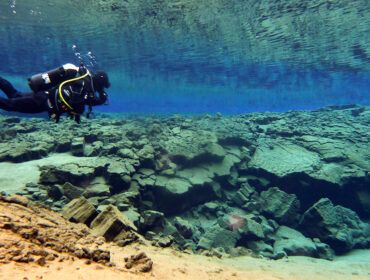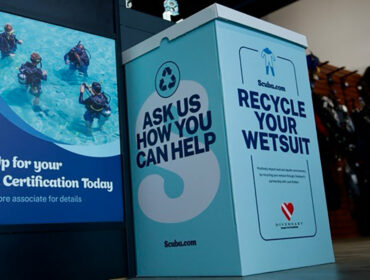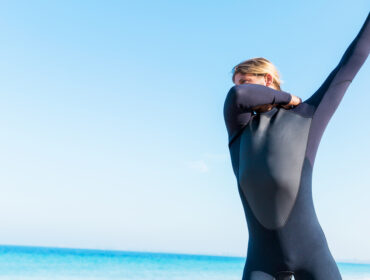Being slightly cold while scuba diving is to be expected, especially if you’re diving two or three times that day. But getting too cold on a dive can actually be dangerous for your health. Staying healthy is the most important thing to consider when scuba diving. So with that in mind, you should avoid the shivers. There are a few ways to stay warm while diving, meaning you can enjoy your dive day comfortably, and stay safe.
Let’s have a look at how you can stay warm while diving, and why it’s important to make sure your body temperature stays regulated.
The dangers of being cold while scuba diving
Did you ever wonder why being in water that is 86˚F (30˚C) feels colder than being in the air temperature which is also 86˚F (30˚C)? This is because water is a better conductor of heat than air is. Water draws away heat from the body almost 25 times more efficiently than air does. This is why even a dive in warm and tropical waters can start to feel cold after a while.
So let’s look at why it’s important to stay warm while diving:
Firstly, it’s uncomfortable to be shivering because you’re too cold on a dive. Your fingers and toes might feel numb, and you can’t enjoy the dive properly. If we’re not relaxed, we will consume our air faster, too.
Next, being cold might increase your risk of getting decompression sickness (DCS). The dive tables and computers that we follow have been developed under the assumption that our blood is moving around our body at the same rate throughout the dive. However, as we get colder, we receive less circulation to the extremities, and this could affect the rate in which nitrogen is off-gassed.
Finally, by becoming too cold, we risk getting hypothermia. When the body temperature drops too low, it’s difficult to replenish the heat that’s needed to maintain normal metabolic and body functions. There are three stages of hypothermia with different signs and symptoms.
Three stages of hypothermia:
- Stage one: Mild to strong shivering occurs, extremities become numb, and breathing becomes shallow and fast.
- Stage two: More violent shivering, disorientation, pale body with blue lips, toes and fingers.
- Stage three: Organs shut down, can’t speak, incoordination. This will lead to cardiac arrest, and death if untreated.
So, now we know why it’s important to stay warm while diving. Let’s look at how we can do this.

How to stay warm while diving
Choose the right wetsuit
Probably the most effective thing you can do to stay warm while diving is to choose the right wetsuit for you. It’s important that the wetsuit is snug and has no holes.
So how do wetsuits work? Wetsuits are supposed to be tight fitting, but they still allow some water inside. The water stays in the small gap between your skin and the wetsuit. Your body heats this small amount of water and the water acts as insulation to help keep you warm.
As well as this layer of water, the wetsuit itself has layers to help keep you warm. Just like on a cold winter’s morning, you would wear layers of clothes (scarf, sweater, jacket, etc), the wetsuit works under the same principle. Multiple layers of thinner material on top of each other work better to warm you up than one thick layer. The layers of the wetsuit trap air in between them which act as an insulator, too.
Neoprene is one of these wetsuit layers. Neoprene is a rubbery material that contains trapped bubbles which are a great insulator. All of these layering factors are what makes wetsuits perfect for keeping you warmer for longer underwater.
How to choose the right wetsuit
So now we know how wetsuits work, we can explore how to choose the right wetsuit. Firstly, get a wetsuit that fits you very well, if it’s too loose (especially on the neck, ankles and wrists) then too much water will leak in and it can’t be insulated by the body. Instead, it will just make us cold.
Next, choose an appropriate wetsuit for the environment. If you’re diving in tropical waters, a shorty would probably be enough to keep you warm for a dive, but if you’re diving in a lake in Europe, you’ll probably need a 7mm. Here’s a rough estimate for which wetsuit to choose for various water temperatures:
- 82-89˚F (28-32˚C): A dive skin or 1mm shorty wetsuit
- 75-84˚F (24-29˚C): A 3mm full-length wetsuit
- 65-75˚F (18-24˚C): A 5mm full-length wetsuit
- 50-65˚F (10-18˚C): A 7mm Full-length wetsuit
If you develop holes or rips in your wetsuit, fix them with a patch or neoprene glue, to avoid leaks. Leaks can add too much water to the gap between your body and the wetsuit, and make you cold.
Wetsuits wear down over time. Because they compress so many times on dives, they lose some of their thickness, and therefore some of their warmth. This is why it’s better to buy new instead of second hand. Even if the used wetsuit looks in good condition, it’s probably not as warm as a brand new one.
Use a drysuit
For water temperatures under 50˚F (10˚C), a drysuit is recommended. A drysuit works completely differently to a wetsuit. As you might be able to guess from the name, a drysuit doesn’t allow water to get inside (unless you forget to zip it up properly!). It is a combination of watertight zippers and wrist/ankle/neck seals.
Drysuits work better to keep you warm than wetsuits because air conducts heat away from the body slower than water does. So you keep hold of your body heat for longer. Most drysuit wearers add warm clothes under the drysuit (instead of a swimsuit) to keep warm.
The air in the drysuit is compressible, just like it is in our other air spaces (mask, lungs, ears, etc). So you have to take this into account and adjust when changing depths. The drysuit is connected to the regulator first stage, and you can inflate and deflate it similarly to a BCD.
It can be tricky learning to dive with a drysuit, it takes some practice to get used to adjusting your buoyancy etc. A drysuit speciality is recommended before taking the drysuit on deeper dives.

Wear a hood, gloves, vest, boots
As well as a wetsuit, you can choose to add extra layers to help keep you warm while diving. We lose a lot of our body heat through our head. A hood is a great piece of diving equipment to help us stay warmer while diving for longer. Hoods are made from the same material as wetsuits are, and work in the same way. It won’t keep your head from getting wet but it will insulate it.
Having cold fingers is a horrible feeling. While wearing a wetsuit your core and limbs can be nice and warm but your fingers could be almost numb from the cold. Diving gloves can be added to keep them toasty.
Cold feet are as bad as cold hands. Dive boots aren’t just for walking to dive sites that are by rocky terrain. They also help to keep your feet warm. You can buy boots in different thicknesses depending on where you will dive.
Finally, a diving vest can be added under your wetsuit for an extra layer of warmth. Some vests even come with a hood attached, this is a great option because it helps to seal the neck to avoid cold water from trickling down your back.
Start the dive warm
This one is pretty self-explanatory. The warmer you are when you enter the water, the longer you will stay warm while diving in the water. So if you sit in the wind in just a swimsuit before diving, you won’t be entering the water with as much body heat as you would if you had been wearing more clothes.
You can drink warm tea, wear a hat, wrap a towel around you, stay dry, and stay out of the wind for extra warmth before and in between dives.
Many divers keep their wetsuits on during surface intervals, but staying wet will make you colder on the next dive. It’s better to get dry and warm up, and put the wetsuit back on right before getting into the water again. Setting up your gear early on, and then staying warm for as long as possible before entering the water is a good way to avoid getting cold before the dive.
Hydrate and don’t skip meals
Did you know that dehydration doesn’t just increase your risk of decompression sickness, it can also cause your core temperature to drop and even cause hypothermia?
Drinking hot or room temperature water, warm soups, and hot drinks like decaffeinated teas can help to keep you warm and hydrated. Some people believe that caffeinated drinks can dehydrate you, however there’s not much evidence of this. However, caffeine can have a diuretic effect (meaning it’ll make you want to pee more), and this can dehydrate you if you’re not drinking enough water to make up for it.
Making sure you have eaten before a dive can help give your body energy. You need energy to keep you warm. However, it’s important to eat the right things that won’t have negative effects on your dive (it’s best to avoid very spicy or oily foods). A good breakfast with fruit, eggs, or oats is great before a dive. Other foods for a dive day include: rice, crackers, cookies, pasta, potatoes, and bread, and proteins like fish and beans, which will keep you fuller for longer and give you energy.
Don’t pee in your suit
While we’re on the subject, let’s address the elephant in the room. Drinking lots of liquids might make you need the bathroom while diving. So will peeing in your wetsuit make you warmer on dives? Many divers believe that it will. However, it’s only a temporary solution to being cold, and it can actually be counterproductive. Warm urine in your wetsuit makes your body think it’s no longer in a cold environment, meaning it stops making as much effort to keep you warm. But then it uses more energy to warm when the warmth is gone and cold water seeps back in. Plus it can make for a smelly suit!

Don’t dive deep
The water temperature drops as you get deeper. So if you’re already feeling the cold in the shallows, going deeper on the dive will only make it worse.
Another reason to stay shallower to be warmer, is that your wetsuit will compress more the deeper you go. This reduces its insulating properties because the little bubbles in the neoprene compress under the extra pressure. At just 33ft (10m) the pressure has already gone from one, to two atmospheres. Times this by three, to 99ft (30m) and three atmospheres of pressure, and your wetsuit has almost no insulation left from the bubbles being so compressed.
So unless you’re exploring deep caves or wrecks, it’s better to stay nearer the shallows, where the sun can still reach you.
Don’t be a hero
If you’re cold while scuba diving to the point of being very uncomfortable, end the dive. Becoming too cold can be dangerous for your health. Your health is the number one priority. No dive is worth risking hypothermia for.
Let your dive guide or buddy know you’re too cold and would like to surface. Don’t worry about spoiling their fun. If you’re feeling too cold, there’s a high chance that they are too!
Now you have all the valuable information in order to stay warm while diving. Stay warm, stay safe, and dive happy.






